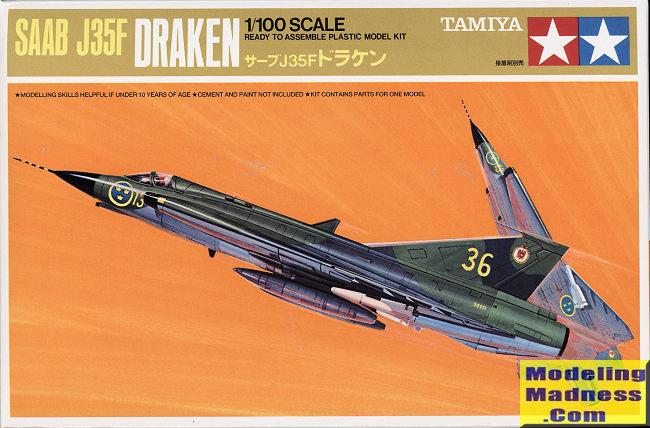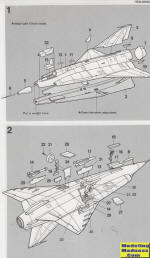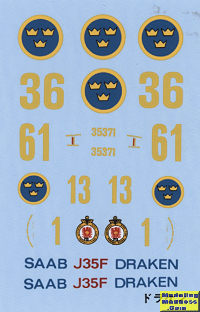
Tamiya 1/100 Saab J.35F Draken
| KIT #: | 60006 |
| PRICE: | Gift |
| DECALS: | Two options |
| REVIEWER: | Scott Van Aken |
| NOTES: | 1968 tooling |

| HISTORY |
As the jet era started, Sweden foresaw the need for a jet fighter that could intercept bombers at high altitude and also take on fighters. Although other interceptors such as the US Air Force's F-104 Starfighter were being conceived during the same period, Saab's "Draken" would have to undertake a combat role unique to Sweden. Other demanding requirements were the capability to operate from public roads, used as temporary airfields and for refueling/rearming to be carried out in no more than ten minutes, even by conscripts with minimal training. In September 1949, the Swedish Defence Materiel Administration issued a request for a fighter/interceptor aircraft, and work began at Saab the same year.
Draken's design incorporated a distinctive "double-delta" configuration, with one delta wing within another larger delta. The inner wing has an 80° angle for high speed performance, while the outer 60° wing gives good performance at low speeds. Propulsion was provided by a single Svenska Flygmotor RM 6B/C turbojet (Rolls-Royce Avon 200/300). A ram turbine, under the nose, provided emergency power and the engine had a built-in emergency starter unit. The Draken could deploy a drag chute to reduce its landing distance.
The double-delta shape was so revolutionary that it warranted the only sub-scale test aircraft built in Sweden: the Saab 210, unofficially nicknamed "Lilldraken" (the little kite). The Saab 210 tested the concept of the double delta, first flying on 21 January 1952. The 210's successful testing results led to an order for three full-size Draken prototypes. The first prototype, not fitted with an afterburner, made its maiden flight on 25 October 1955. The second prototype, equipped with an afterburner, on its first flight, unintentionally broke the sound barrier while climbing.
Although not designed to be a dogfighter, the J 35 Draken proved to have good instantaneous turn capability and was a very capable fighter. It entered service in 1960 with the Swedish Air Force; 644 Saab Drakens were built for Sweden as well as other European nations. Sweden's Draken fleet came in six different variants while two Draken models were offered for export. The early models were intended purely for air-defense. The last model built was the J 35F, the final variant to remain in Swedish service. These aircraft have now been retired and replaced by the Saab Gripen.
The J 35 Draken design underwent several upgrades. The last was the J 35J version, in the late 1980s, although by then, the Draken had been almost totally replaced by the Saab Viggen in Swedish service. The J 35J was a service-life extension program since the delivery of the new Saab JAS 39 Gripen was still in the development stage and suffering from delivery delays. The extension program was to keep the Draken flying into the 2000s, but due to cutbacks and high maintenance costs the Draken was eventually phased out. The Swedish Drakens were officially retired in December 1998, although the type remains in limited numbers in both military and civilian versions. Export customers included Denmark and Finland. In 1985, the Austrian Air Force purchased 24 J 35D s totally reconditioned by Saab, designnated J 35Ö.
All Drakens are interceptors with limited air-to-ground capability, with the sole exception of the Danish Drakens, which are strike aircraft capable of carrying AGM-12 Bullpup missiles, advanced "jammers", and increased internal and external fuel stores. The Danish Drakens are so far the heaviest of the series to have been in service. Danish F-35 aircraft were retired in 1993.
Finland updated its 35X fleet with new avionics, cockpit displays, navigational/attack systems and electronic countermeasures during the 1990s but finally retired the Draken in 2000.
Austria was the last country to operate the Draken in military service. They bought refurbished J 35D which was the last variant with two internal cannon due to the Austrian restriction of not being allowed to carry air-to-air missiles. These Drakens were retired in 2005, when they were replaced by former Swiss Tiger IIs, while waiting for new Eurofighters.
In the United States, the National Test Pilot School (NTPS) owned six Drakens that were formerly in Danish service; of these, two TF-35XD s and one RF-35XD were operational, based at the Mojave Spaceport.
| THE KIT |
 Back
in the late 1960s, Tamiya was getting underway with its kit program. They
felt that the proper scales for aircraft were 1/50, 1/72, and 1/100. The
only reason they did not choose 1/75 instead of 1/72 is that the somewhat
larger scale had already been pretty well decided by Frog and Airfix. The
other two scales did not see much acceptance outside of Japan and
eventually, Tamiya relabeled their 1/50 kits in 148. After producing about
two dozen military kits in 1/100, Tamiya dropped the idea. However, that has
not stopped them from reissuing them from time to time. In truth, they are
nicely done kits for the most part, though do require a few of those
building skills to complete.
Back
in the late 1960s, Tamiya was getting underway with its kit program. They
felt that the proper scales for aircraft were 1/50, 1/72, and 1/100. The
only reason they did not choose 1/75 instead of 1/72 is that the somewhat
larger scale had already been pretty well decided by Frog and Airfix. The
other two scales did not see much acceptance outside of Japan and
eventually, Tamiya relabeled their 1/50 kits in 148. After producing about
two dozen military kits in 1/100, Tamiya dropped the idea. However, that has
not stopped them from reissuing them from time to time. In truth, they are
nicely done kits for the most part, though do require a few of those
building skills to complete.  Instructions
are well done with generic color information. There are basically just two
assembly steps. Though only one markings option is shown, you have numbers
included for a second option. These were both painted the same with dark
olive green and dark blue on the upper surfaces with what is shown as light
blue on the underside. I'm not sure this is correct for the underside. When
I built Hasegawa's 1/48 kit many years ago, the underside was unpainted
metal for the center section with a medium grey for the rest. This is
obviously one of the more recent releases as the decals are in great shape
and should work great if you use fairly hot water. Missing from the
decal sheet are the intake warnings.
Instructions
are well done with generic color information. There are basically just two
assembly steps. Though only one markings option is shown, you have numbers
included for a second option. These were both painted the same with dark
olive green and dark blue on the upper surfaces with what is shown as light
blue on the underside. I'm not sure this is correct for the underside. When
I built Hasegawa's 1/48 kit many years ago, the underside was unpainted
metal for the center section with a medium grey for the rest. This is
obviously one of the more recent releases as the decals are in great shape
and should work great if you use fairly hot water. Missing from the
decal sheet are the intake warnings. | CONCLUSIONS |
While not everyone's choice of scales, these are good kits for fairly new modelers. They also have the benefit of not taking a lot of space on shelves, especially if you open the hole on the lower fuselage and use the kit's stand.
| REFERENCES |
November 2020
Copyright ModelingMadness.com. All rights reserved.
If you would like your product reviewed fairly and fairly quickly, please contact the editor or see other details in the Note to Contributors.
Back to the Main Page Back to the Review Index Page Back to the Previews Index Page